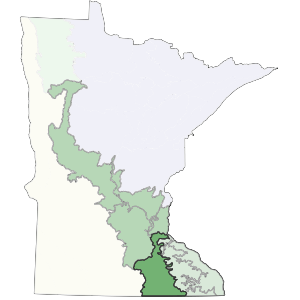The western boundary of this subsection consists of a series of end moraines that disrupted the spread of prairie fires from the west but did not provide sufficient protection for hardwood forests to become established. The subsection is bounded on the east by land dominated by hardwood forest. This boundary coincides with a increase in loess thickness. The northern boundary separates calcareous gray Des Moines lobe glacial till from red Superior lobe glacial till.Much of this subsection is a rolling plain of loess-mantled ridges over sandstone and carbonate bedrock and till. At the southwestern edge of the subsection are moraine ridges. They are a continuation of those present in the Big Woods subsection, but smaller. As a result, fires from the surrounding prairies to the south, west, and east burned the landscape frequently enough to maintain oak opening rather than forest (Albert 1993). Presently, most of the subsection is farmed.
Landform
Much of the subsection is a loess plain over bedrock or till. Also included are Late Wisconsin end moraines, stagnation moraines, and outwash. Topography is gently rolling. The subsection contains few lakes. Stagnation moraines in the southwest are not large, but slopes are often steep.


